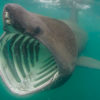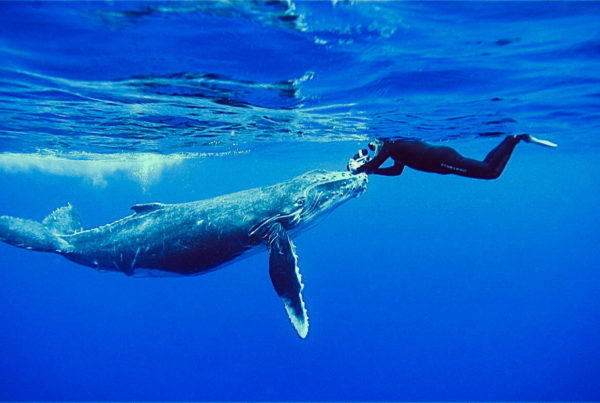Please envision yourself diving along your favorite California reef. The sea is calm, the water clear, and the sun shines bright. Out of the corner of your eye a once-in-a-lifetime subject swims by right in front of your camera. It could be a whale, a shark, or a tiny fish that has never been photographed. You know that if you get the shot it will make the cover of a major magazine, or at least a Facebook post that will get you millions of “likes.” Chills run down your spine and your heart races — and you begin to loose your concentration in the excitement of the moment. So how do you reestablish your composure to take advantage of this remarkable encounter?
It’s simple. You need a mantra.
A mantra is generally defined as a word, phrase or sound repeated to aid concentration in meditation. Hindus and Buddhists use mantras to achieve a deep meditative state, but underwater photographers can use one to calm themselves when they encounter that special subject, or seek inspiration to capture an exceptional image of a common or ordinary critter. The Photographer’s Mantra is simple: get close, get low, shoot up.
Get Close
As an underwater photographer, it might be difficult to accept the concept that water is your enemy. Water, especially the rich waters of California, has quite a bit of what scientists call suspended particulate matter, which, scientifically includes plankton and sand, and unscientifically includes what we’ll call schmutz and sparkly bits. No matter what the suspended materials are, they have two effects on your images. First, they reduce the sharpness of your images, giving them a hazy, fuzzy look. Second, if you are using a strobe the particles reflect light back into your lens, causing what we photographers refer to as backscatter.
The relationship between water and image quality is simple — the more water you have between your lens and subject, the less sharp your image will be and the more backscatter you will experience. When you get closer to your subject you will get clearer, sharper images. This is why photographers rarely use “normal” or telephoto lenses underwater; they use close-focusing macro and wide-angle lenses (or even ultra wide-angle lenses). These lenses get the water out of the image by enabling the lens to focus close to the subject. Serious photographers tend to avoid lenses (or cameras with fixed lenses) that have long minimum-focus distances.
Getting close has another advantage; it allows you to fill the frame with your subject. It is generally a bad idea to expect your audience to hunt for the subject in your image. You’ll understand what I am talking about if you have ever looked an image and asked: “What am I looking at?” The primary subject should “pop” out of your image. Your audience may not know the name of the critter they are looking at, but they should easily identify the subject. Getting close to your subject makes composition that much easier. Select a lens (or a focal length on your zoom lens) that will allow you to fill your frame with your subject at the minimum distance your subject will allow, or as close as you are comfortable approaching a large animal.
Get Low.
Images taken above a subject and looking down are often boring because the subject generally blends into the background and is hard to locate. Such images lack what photographers call separation — the difference in color, texture or focus that allows viewers to readily distinguish the subject from its background. Better images are created when you get level with or even below your subject. This position allows you to obtain a bold perspective on your subject, and enables you to isolate your subject from its background and create images where the subject is not lost in the clutter of the background. This low position also provides endless opportunities to control your backgrounds.
Another reason is not obvious but very important — getting down gives you a better opportunity to find subjects! Many critters are superbly camouflaged when viewed from above, but are often easily located when viewed from the side.
Shoot Up.
Shooting up allows you ultimate control of your background to enable images that explode off the page or screen. By shooting up you can create a jet-black background, a blue or green background, or a background dominated by the sun and its rays. It’s all about the juxtaposition of your subject, camera and the sun. Use a small aperture and point your lens away from the sun and the background goes black. Select the appropriate aperture and at aim at point near the sun, and the water will be bright and colorful. Aim right at the sun and the background will be dominated by a sunburst and the subject will really jump off the page. Even if you cannot obtain a clear water background, you can still isolate your subject by framing it against a more distant and thus out-of-focus background.
I normally take a few images of the background sans the subject and optimize the exposure of the background of the image I have in my mind. This is usually done with a manual exposure setting. I then adjust the output of my strobes to properly expose the subject. This process works best for stationary macro subjects or with cooperative divers. However, it never works for moving subjects that may only allow you the opportunity to obtain a limited number of images, and certainly no time to review each image before shooting the next. Under these circumstances you have to guess on exposure settings and hope for the best. Generally, some automatic exposure control with little or no strobe fill is a good starting point. If your subject exhibits some form of repetitive behavior, you may have time to review your images and compensate. Automatic bracketing (setting your camera to take three or more images at different exposures) may also increase the odds that you get one exceptional image out of the experience.
What’s not so obvious is shooting up creates a perspective that encourages your subject to show off its personality. Good photography captures a moment. That special expression, position of a fin, or twinkle in the eyes often separates a good image from a great one. Shooting up allows those great expressions of what it means to be that fish or seal to be clearly recorded, and not lost in the clutter of the background.
The photographer’s mantra is perfect to calm yourself when you happen on that once-in-a-lifetime subject. It’s also useful to focus your mind on that perhaps ordinary subject at hand and capture it in a more appealing composition. It is all to easy to snap an image of an animal and move on to the next. Chant the mantra when you encounter a subject and let it lead you to new levels of creativity.
So, whenever you encounter that ordinary or extraordinary subject, remember the mantra: get close, get low, shoot up. This simple phrase often allows you to focus on important elements of your image, and capitalize on the moment before it is lost.










